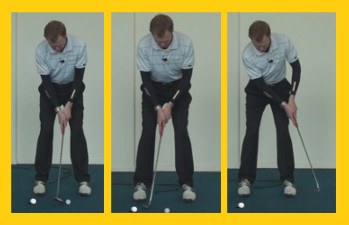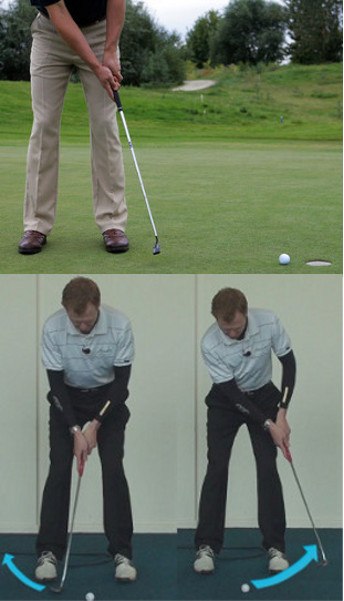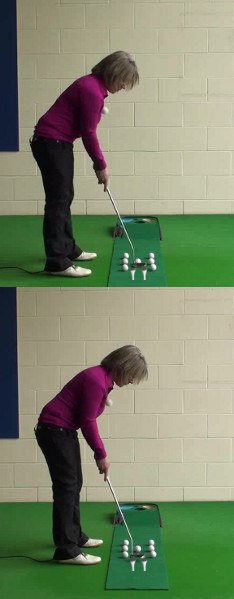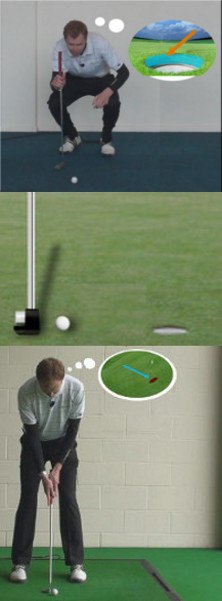
When you miss a putt to the left, do you automatically think, I pulled it because my stroke was off line, or, I must have lined up incorrectly? While either of those may be true, it's more likely that you decelerated the putter.
Deceleration is when the putter slows down as it approaches the ball, rather than accelerating or speeding up. When we decelerate, the putter face usually closes just a fraction – enough to send even the shortest putts wide of the mark. Of course, decelerating can cause you to come up short as well.
Amateur players tend to decelerate when they're uncertain. Perhaps the greens are exceptionally fast and you're afraid of blasting the ball too far. Or maybe you're unsure of the line and respond with a tentative stroke. Sometimes, a lack of confidence causes us to try and guide the ball into the cup, rather than make a smooth, authoritative stroke. Other times, our back-stroke is simply too long, leaving us no choice but to instinctively slow down coming through.
While there's no tip or drill guaranteed to cure you of this problem, here are a couple that should help.

Aim for a spot past the hole:
- On the practice green, set out several balls 2-3 feet from the cup.
- Pick a spot 8”-12” inches past the hole, on your through-line.
- When setting up, look at the spot rather than the hole, then stroke the ball as though trying to hit the spot.
- The hole should essentially “get in the way,” with the ball hitting the back of the cup.
- Integrate the same method into your on-course routine.
Short back, long through:
- Starting from close range on the practice green, place a ball about 6” behind the ball you'll be putting.
- Take the putter back without touching the ball on your line.
- Make a follow-through that's longer than your back-stroke.
Both drills will ingrain an accelerating stroke that stays on track from start to finish and gets your putts to the hole.

Deceleration Deadly During the Putting Stroke
The task of rolling the ball toward the hole doesn't seem particularly difficult on the surface. After all, hitting the ball hard enough to roll it along the ground for a few feet is certainly easier than trying to hit the ball hundreds of yards in the air. Despite the seeming simplicity of the putting stroke, any experienced golfer knows just how difficult putting can be. Many find this to be the hardest part of the game, so it would be a mistake to take putting for granted. If you are interested in shooting lower scores in the months and years to come, refining your stroke is something which should be at the top of your priority list.
In this article, we are going to take a look at one of the worst mistakes you can make while putting – decelerating the club through the hitting area. Simply put, deceleration takes place when you allow the putter to slow down during the forward stroke. This might not seem like a particularly big deal on the surface, but deceleration will cause two serious problems. First, it will make it hard to hit your target line accurately. Second, even if you do hit your line, it will be tough to control your speed. Obviously, line and speed are the two main components of any putt, so deceleration cuts to the very heart of what you are trying to do with the flat stick.
As you will see highlighted in the instruction below, this is a problem which is both mental and physical in nature. In fact, most golfers have problems with deceleration due to mental game mistakes, rather than problems with their technique. We are going to highlight all of the various causes of this problem so you can get down to work on straightening it out once and for all. With the deceleration properly eliminated from your stroke, you should be able to stand over the ball with an increased level of confidence moving forward.
Before getting too far into deceleration, we should highlight the fact that the rest of your technique needs to be in good condition if you are going to make putts. Accelerating the putter through the ball is important, but that alone will not cause the ball to fall in time after time. Only when you pair up nice acceleration with a solid based on fundamentals will you be able to knock the ball in to the back of the cup. Some of the basics of solid putting technique which you should watch carefully as you practice include a balanced stance, stable head position, relaxed grip pressure, and more. Pay attention to the small details within your stroke as you practice, since it is those small details which will add up in a big way on the greens. Golfers who are willing to work hard on the little stuff are the ones who perform well with the putter.
All of the content below is based on a right-handed golfer. If you putt left-handed, please take a moment to reverse the directions as necessary.

The Many Causes of Deceleration
Anytime you have a problem in your golf game, the first step is to look for potential causes of that problem. You need to know what it causing your game to go off track before you can actually fix it correctly. If you never do manage to find a root cause, you will simply be putting a bandage on one problem – only to create another. By peeling back the layers and figuring out what is at the heart of the matter, you can make true improvement in your game.
With that in mind, let's take a look at some of the common causes of deceleration in the putting stroke. Think about each of these points individually to decide whether or not they apply to you. Most likely, the underlying cause of your deceleration problem is going to be found somewhere within this list.
- Making a long backstroke. This is probably the leading cause of deceleration among amateur golfers. When you swing the putter back too far, the natural reaction on the forward swing is going to be to decelerate the club prior to impact. After all, if you make a backstroke which is too long for the putt at hand, and then you accelerate the club from there, you will inevitably hit the putt too hard. To avoid this mistake, you need to tighten up your backstroke. Don't let the club drift back farther than is needed – keep things tight, swing the putter back just far enough, and then accelerate through to send the ball to the hole. This style of putting will take a little bit of practice to master, but you will be far more effective in the long run once you have it down.
- Looking up early. Another physical mistake you can make which will result in deceleration is looking up early to see where the ball is going. When you move your head and shoulders up out of the putt, the club will slow down and you will be likely to leave the ball short of the hole. There is really no excuse to make this mistake, as it simply comes down to a lack of discipline. Before starting each stroke, commit yourself to watching the ball all the way through the stroke until it has been sent on its way. Remember, looking up early isn't going to do you any good in terms of causing the ball to go in – you have no control over the ball once it leaves your putter. Keep your head down, stay steady through the stroke, and trust yourself to hit a good putt.
- Getting nervous. It is normal to be nervous over certain putts during the course of a round. If you do get nervous, you will need to watch out for the possibility of decelerating through the ball. Your nerves will tend to cause your muscles to tighten up, and tight muscles rarely allow the putter to swing freely. A good putting stroke is a fluid motion, so you need to do your best to stay relaxed. Even something as simple as a deep breath before taking your stance can go a long way toward promoting a quality stroke which accelerates through the ball. There is no way to completely eliminate nerves from the picture while you play, but you can work on learning how to perform well even while those nerves are present.
- Playing too much break. This is a point you might not think about as being part of this equation, but it actually plays a big role in the kind of stroke you make. Imagine for a moment that you are facing a putt which is going to break from right to left. There is no doubt that is will break to the left – you are simply trying to figure out how much it will break. If you play a lot of break, possibly more than necessary, you may find that you decelerate your stroke on the way through as a way to avoid hitting the putt on the high side. After all, if you play a lot of break and then hit the putt hard, it is sure to stay high. By decelerating, you will take speed off the ball and give it a chance to fall back onto the proper line. So how do you avoid this mistake? Simple – think about the speed you are going to use while picking out the line for your putt. If you plan to hit a soft putt with plenty of break, that's fine – but you need to make an accelerating stroke which matches your intended speed. Line and speed will forever be linked when it comes to putting, so always think about one when considering the other.
If you consistently decelerate your putter while making a stroke, it is very like that one of the issues above is to blame. Once you have decided which of these problems is a reality for you, the next step is to begin looking for a solution. The good news when it comes to working on your putting is this – once you find your solution, it shouldn't take too long to work it into your game. Fixing your stroke is a quicker process than fixing your swing, so improved results may be right around the corner.

A Simple Drill
It is always a good idea to use golf drills in order to iron out any mistakes which may be present in your technique. When it comes to decelerating the putter, there is one drill specifically which will be tremendously helpful in improving your performance. We are going to lay out that drill in the step by step instructions below – and as you will see, it is a simple drill which requires only a few basics pieces of equipment and some space on the practice green in which to work.
To try this drill out during your next visit to the putting green, follow the steps below.
- To perform this drill, you will need your putter, a few golf balls, and a handful of tees. Also, you will need to find a hole on the putting green you can use. Ideally, this hole will be in a mostly flat section of the practice green. You are only going to be putting from a few feet away, so you don't need to find a large open section of the green in order to use this drill.
- Once you have selected your hole, take two steps away from that hole and place a tee in the ground to mark the point where you will putt from. For most people, those two steps are going to cover approximately six feet, so these are not going to be long putts.
- Place a golf ball down next to the tee and stand over the ball as though you are about to hit a putt. Once in your stance, take your right hand off the putter while holding the putter in place with your left. Bend down and push two more tees into the turf – these tees are going to be behind the putter head, in a position where they will limit the length of your backswing. Swing you are only hitting short putts with this drill, these 'stopper' tees should be just a few inches behind the position of your putter head.
- With the stage now set, go ahead and hit a few putts. You will notice right away that you have to keep your backstroke nice and tight in order to avoid hitting the stopper tees. This may be uncomfortable at first, but stick with it until you start to get a good feel for accelerating through the ball. Most likely, you will begin to hole putt after putt as you gain confidence in this method.
Now that you have a good understanding of this drill, you can feel free to use it on a variety of other putts around the green. Of course, if you set up for longer putts, you are going to need to provide yourself with more backstroke space in order to hit the ball hard enough. Always set up the drill to where you can comfortably hit the ball hard enough to reach the hole, while still not giving yourself too much room to make a long backstroke. You always want to feel like you need to accelerate the club slightly through impact in order to reach the target.

Getting in the Right Frame of Mind
As was mentioned in the introduction, deceleration during the putting stroke is as much about the mental side of the game as it is about your physical technique. Putting is always a big mental challenge, as the physical act of rolling a ball across the ground to a hole just isn't that complicated. Without the mental side of putting, it would be pretty easy indeed. You can't just get rid of the mental side, however, as it is always going to be there for as long as you are playing this game.
So what can you do to get your might 'right' before hitting putts during an upcoming round of golf? The following mental game tips should help you attain the focus and attitude you need.
- Accept the possibility of a miss. This might seem like a strange way to start our list, but accepting the possibility that you may miss your putts can actually be a freeing feeling. There is only so much that you can control while on the greens – once the ball leaves your putter, you can't do anything about whether it falls in or not. Rather than trying to 'force' the ball to go in, you need to have the perspective of doing your part and then watching the ball roll while hoping for the best. You are going to miss putts in every single round you play – that is just a fact of life in golf. Accepting the fact that some of your putts won't go in will do wonders for the attitude you take onto the greens. You can still be confident in your abilities, but you need to understand that you can't force the ball to drop in the cup.
- Focus, focus, focus. When putting, you need to focus on the task at hand. This can be difficult for some golfers, however, as the rest of your playing partners will be standing around you on the green. You might find that you are distracted by watching what they are doing, or you may get caught up in conversation prior to hitting your putt. This isn't so much of a problem back in the fairway when all of the players in the group are scattered around the fairway. While there is nothing wrong with being social on the course, you need to know when the time comes to focus. Try to avoid conversation prior to hitting your putts, instead using that time to get your read and plan the appropriate speed for your stroke. Once the hole is completed, feel free to chat with your playing partners on the way to the next tee.
- Don't get ahead of yourself. You don't want to be putting while thinking about what might happen on future holes, or what score you might record at the end of the day. For instance, you shouldn't be thinking that you need to make this putt because it will get you back on track for shooting a good score. Instead, you should just be doing your best to knock the ball in the hole. Avoid thinking in terms of the big picture while you are on the course. Stay dialed in on the shot by shot process of getting through the round and save the math of adding up your score for after you are back in the clubhouse.
You should always be aware of how you are using your mind on the golf course, whether you are putting or hitting a full shot. While most amateur golfers think that their swings needs the most work, it is often the mental game which has the farthest to come. Learn how to think effectively and your results should improve without many physical changes being required.

Accelerating on Short Putts
Before we conclude this discussion of deceleration in the putting stroke, it is necessary to specifically highlight your performance on short putts. Nothing will derail a good round of golf faster than missing a few short putts, so you need to be confident and consistent from inside of five feet. Unfortunately, this is the range that causes many golfers to decelerate right before the moment of impact.
If you are decelerating frequently on your short putts, it is probably because you are trying to 'guide' the ball into the hole. You think that you should make all of these short putts, so you hit the ball softly and hope that it will find its way to the bottom. Of course, that really isn't the right approach to this situation. Instead, you should be making a short, aggressive stroke which accelerates all the way through impact. Accelerating the club through the ball is going to help you hit the target line, which is obviously vital from short range. The simple drill we provided earlier, where you use tees as stoppers to keep your backstroke short, is a great one to use when dialing in your performance on short putts.
When on the course, don't treat your short putts any differently than you treat all the rest of your putts. Don't hurry through your preparation for a short putt, but don't take any extra time, either. Stick with your usual routine, keep yourself comfortable, an make sure your balance is excellent from start to finish. A big part of making short putts is having confidence in your ability, so make plenty of them on the practice green prior to starting any round in order to boost your attitude. Every golfer will miss a short putt from time to time, but you should be able to handle most of them without a problem as long as you have a plan.
Deceleration can destroy a putting stroke, but there is no need to let it wreak havoc on your technique. You can avoid deceleration by paying attention to your fundamentals, keeping your confidence high, and using the simple drill provided earlier in this article. When you know that the putter is going to accelerate through the ball properly time after time, you will feel good about your chance to make a lot of putts each and every day. And, when you feel confident about your putting stroke, you will likely find that your confidence is increased around the rest of the course as well. Good luck!






